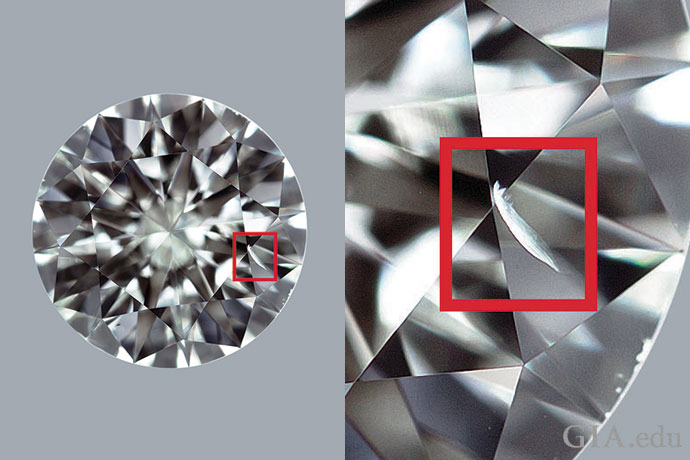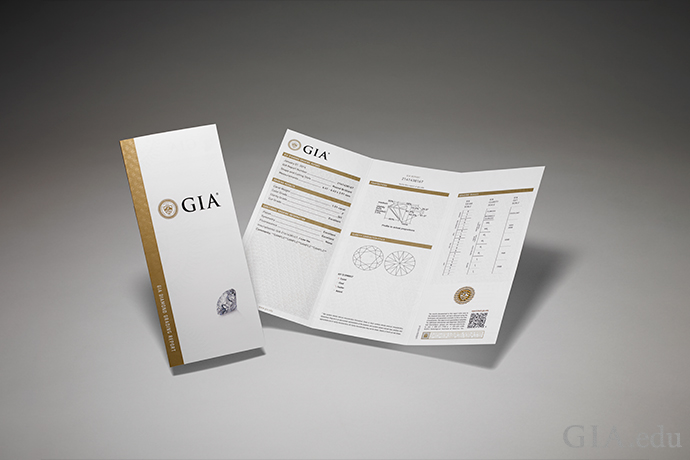A VVS diamond (Very Very Slightly included) and a VS diamond (Very Slightly included) differ in clarity and, if all else is equal, they can differ significantly in price. Knowing these differences can help you make a smart engagement ring purchase.

VVS Diamond versus VS Diamond: Why you need to know the difference
If you’ve been comparing diamonds for an engagement ring purchase, you’re no doubt already aware of the GIA 4Cs of diamond quality: Color, Clarity, Cut and Carat Weight. You’ve noticed that diamond quality and size are related to price. That’s because larger diamonds that are graded high on the color, clarity and cut scales are rarer, so they cost more. But in comparing diamonds of equal size, you may have also discovered that even the smallest differences in grades – quite often impossible to detect with the naked eye – can have a significant impact on price.

In this blog, we’ll focus on diamond clarity grades – specifically, on two grading categories that seem to generate a lot of questions and discussion online: VVS (Very Very Slightly included) and VS (Very Slightly included). There are two subcategories within each of these (VVS1 and VVS2, VS1 and VS2) that represent the ease with which the defining clarity characteristics can be seen when the diamond is examined face-up under 10× magnification. Both a VVS diamond and a VS diamond will have clarity features that in almost all cases cannot be seen with the naked eye. Yet, price differences between these two diamonds can be as high as 30%. For example, according to a 2018 diamond pricing sheet used by most wholesalers and retailers, a 1.00 carat (ct), D color, VVS1 diamond can be 20%–30% more expensive than a VS1 diamond of the same weight and color. A 1.00 ct G-H color, VVS1 diamond can be 15%–20% more expensive than a comparable VS1 or VS2 diamond.
If you’re buying a diamond of this quality, the difference in price can be significant. That’s why it pays to learn about these two clarity grade categories and what goes into determining the difference in clarity between a VVS diamond and a VS diamond.

Can you tell the difference between these two 1.00 ct, G color, Excellent cut round brilliant diamonds? The diamond on the left has a clarity grade of VVS1 and costs 15% more than the VS2 diamond on the right.
Diamond clarity: blemishes and inclusions
Diamond clarity refers to the internal and external features a diamond acquires in the journey from formation through cutting, polishing and daily wear. Some incorrectly call these features “marks” or “flaws.” The correct term is “clarity characteristics” and they contribute to every diamond’s unique identity.
There are two types of clarity characteristics: blemishes and inclusions. A blemish is an external feature that is confined to the surface of a diamond. Examples would be extra facets, naturals (remnants of the original crystal surface), polish lines and abrasions on facet junctions.
An inclusion is an internal feature that is either totally enclosed within a diamond or extends into the gem from its surface. Common inclusions are feathers, crystals, pinpoints, clouds (groups of pinpoints), internal graining, needles or indented naturals (that is, naturals that extend below the surface of the diamond). For photos and detailed descriptions of these and other clarity features, check out our blemish and inclusion blogs.
Blemishes usually only affect the clarity grade in the top two categories (Flawless and Internally Flawless), whereas inclusions affect all grades. For VVS and VS diamonds, then, we’ll focus on inclusions.

A pinpoint is a very small crystal inclusion contained within the diamond that looks like a tiny dot at 10× magnification. This diamond contains a few pinpoints with a larger included crystal above them.

Clouds consist of groups of pinpoints that might be too small to distinguish individually but together have a hazy appearance.
Diamonds with few or no clarity characteristics are very rare. So, all else being equal, diamonds with fewer inclusions – or smaller, less noticeable inclusions – are usually more expensive than diamonds with more inclusions – or larger, more obvious ones. That’s why, all else being equal, VVS diamonds will cost more than VS diamonds.
However, a clarity grade is more than letters and numbers. To understand the difference between the VVS and VS grades, let’s look at how GIA grades diamonds and what the different categories represent for your diamond.

A visible inclusion would mar the beauty of this 3.30 ct Asscher cut, H color, VVS1 clarity diamond.
How GIA determines clarity grades for diamonds
In the GIA clarity grading system, 10× is the standard magnification used to determine a diamond’s clarity grade. While a GIA diamond grader will use her trained eye and a microscope at increased magnification to examine a diamond, she makes the final grading call based on what she can see using a standard 10× jeweler’s loupe.
In arriving at a clarity grade, the grader takes into account five factors:
- Size: When all other factors are equal, the larger the inclusion or blemish is relative to the size of the diamond – and, therefore, the more visible it is – the lower the diamond’s clarity grade will be.
- Number: When all other factors are equal, the more inclusions, reflections of inclusions or blemishes visible face-up at 10× magnification, the greater their effect on the clarity grade will be.
- Location: This refers to the position of an inclusion or blemish. The closer an inclusion is to the center of the table, the greater effect it will have on the clarity grade.
- Relief: This refers to the contrast between the inclusion or blemish and the diamond. Generally, the more the clarity feature differs in brightness, darkness or color from the diamond, the more visible it is and the greater its impact on the clarity grade will be.
- Nature: Here the grader looks at the type of characteristic and what inherent effect it has on the appearance of the diamond. In other words, some inclusions or blemishes can have a greater impact on the clarity grade than others.
After the GIA grader has identified all the diamond’s clarity characteristics and taken into consideration the five factors listed above, the diamond is assigned a clarity grade based on the following criteria:
| Clarity Grade | Visibility at 10× Magnification |
| Flawless (FL) | No inclusions and no blemishes visible at 10× magnification |
| Internally Flawless (IF) | No inclusions and only insignificant blemishes visible at 10× magnification |
| Very Very Slightly included (VVS1 and VVS2) | Minute inclusions that range from extremely difficult (VVS1) to very difficult (VVS2) to see at 10× magnification |
| Very Slightly included (VS1 and VS2 ) | Minor inclusions that range from difficult (VS1) to somewhat easy (VS2) to see at 10× magnification |
| Slightly Included (SI1 and SI2) | Noticeable inclusions that are easy (SI1) or very easy (SI2) to see at 10× magnification but usually are not eye visible |
| Included (I1, I2 and I3) | Obvious inclusions visible at 10× magnification – and often seen with the unaided eye |

A pair of pears plus one: Two colorless pear shaped diamonds play the supporting role to a 1.54 ct Fancy Intense yellow diamond in this platinum engagement ring. All three diamonds are VVS2 clarity.
What is a VVS diamond?
As indicated in the above clarity grade chart, a VVS diamond contains minute inclusions that range from extremely difficult (VVS1) to very difficult (VVS2) to see at 10× magnification. Typical inclusions that might set the VVS grade include:
- Pinpoints, needles, internal graining or clouds that are visible only through the pavilion (the portion of a polished gem that is below the girdle) or are extremely difficult to see face-up at 10× magnification (VVS1)
- Pinpoints, needles, internal graining or clouds that are very difficult to see face-up at 10× magnification (VVS2)
- Minute surface-reaching inclusions (chip, cavity, feather, bruise, bearding, indented natural, etc.)
A diamond with eye-visible inclusions would not receive a clarity grade of VVS1 or VVS2.

Internal graining is a type of inclusion caused by irregularities during crystal growth that can appear as lines, angles or curves. For this diamond, the nature of the inclusion and its location in the diamond’s pavilion contributed to a clarity grade of VVS1. Had the same inclusion been located under the diamond’s table, the diamond might have received a lower clarity grade.

This diamond has a clarity grade of VVS2. The red box surrounds a tiny feather that is very difficult to see face-up at 10× magnification. A feather results from a break along one of the diamond’s four octahedral planes. Feathers can appear white or transparent. In this example, the feather would likely be hidden by a prong when the diamond was set.
What is a VS diamond?
A VS diamond contains minor inclusions that range from difficult (VS1) to somewhat easy (VS2) to see at 10× magnification. Many different types of inclusions are possible, but they must be very small relative to the size of the diamond. Typical inclusions that might set the grade include some crystals, knots or distinct clouds, or minor surface-reaching features such as a feather, cavity or indented natural. In very rare cases, a large VS stone might contain an eye-visible inclusion.




A GIA Diamond Grading Report gives you the information you need to buy a diamond with confidence.
Get a GIA Diamond Grading Report for an accurate and unbiased clarity grade
Regardless of which clarity grade you choose, you’ll want to make sure the diamond was graded by GIA. This will ensure that its clarity assessment – along with its color, cut and carat weight – is accurate and objective, and adheres to the exacting grading standards GIA developed.

The small crystals under this diamond’s table qualify it for a VS1 grade.

This clarity plot of a VS2 diamond shows the grade-setting inclusions, a few crystals under the table, and a cavity on the pavilion.
A Diamond Grading Report not only contains the diamond’s clarity grade, but it also provides a plotted diagram. The diagram maps the inclusions and/or blemishes observed at 10× magnification on the table and pavilion, showing you their approximate shape and location on the diamond. The diagram serves to document the diamond’s condition at the time it was graded and supports the diamond’s clarity grade. And, because no two diamonds will have the same plotted diagram (unless they are both Flawless), it serves as a means of identification.
Picking out an engagement ring often means being confronted by a thousand small decisions. So much emotion and symbolism – along with financial considerations – are wrapped up in an engagement ring. But at the end of the day, it comes down to a personal decision only you can make. Remember: There is no “wrong” answer when it comes to a gift given with love.
Ready to consider diamond shapes? Here’s a post that will walk you through each one.
https://ift.tt/2vEfuk6
No comments:
Post a Comment